Walmart vs. Whole Foods: an environment indicative of society’s values
The difference amid two grocery stores is indicative of society’s ever changing values, trends, stereotypes, ethics, and costumers. The values differ greatly amid the grocery stores, Walmart and Whole Foods, which is clearly portrayed below in the evaluation of comparable products.
Pastries
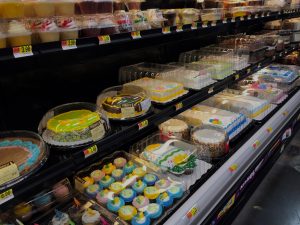
Walmart’s cakes

Whole Food’s cakes

Walmart’s cupcakes

Whole Food’s cupcakes
To begin with something sweet, the cakes and pastries of the stores are indicative of their specializations and environments. Walmart displays its cakes and cupcakes in a film of hard plastic, covered with brightly colored icing, and in mass assemblage. Little individualization is found within them, with their simple icing and plastic ring placed on top. Also, they advertise mass idealized subjects in their cupcakes. For example, the red cupcake has a captain america ring on top.
Whole foods, however, approaches it’s bakery as one in and of itself. It is as if their bakery is a bakery within the store rather than merely a section of the store. This ideal promotes the prospect that when one enters, it is an experience, not merely a place to purchase groceries. The individual decorative cakes are displayed without packaging, illustrating the artistic capabilities of the baker and icing decorator. This contrast is also projected in the price of each of their cupcakes. Walmart, having a simple mass produced cupcakes, prices them at 98 cents, whereas whole food’s prices their cupcakes at a whopping $4.25, paralleling to the price at a speciality cupcake store.
Paper Towels
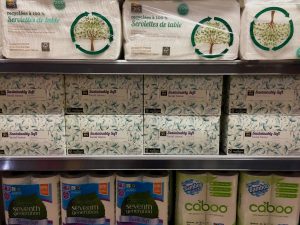
Whole Food’s paper towels
When evaluating the paper towels and tissues, the prospect of ethos groceries becomes a prevalent topic for discussion, for the paper towels at Whole Foods are all advertised as sustainable. For example, the brand or signature labelling of one product is “Sustainably soft.” The idea of ethos groceries, that one is purchasing more than just a good and instead promoting a societal or political aim, is demonstrated in these paper products. Also there is a small selection, which assumes that all possess the capability to purchase such goods,

Walmart’s paper towels
more expensive moral goods.
The goods of Walmart, however, are found in mass production upon a large aisle. Rather than deciding the option that is the most sustainable, the best price or the most well known brand gets chosen. This is indicative of a society dependent upon purchasing goods at the best price, likely the middle class. Also, because the paper products are in mass, the idea of “the bigger the better” idea becomes prevalent. Instead of purchasing the most sustainable option, they purchase the most large or
“best for the the price” paper product.
Cheese
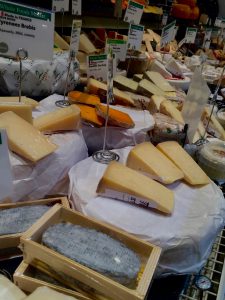
Whole Food’s cheese
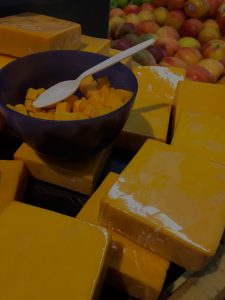
Whole Food’s samples
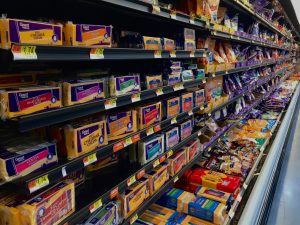
Walmart’s cheese
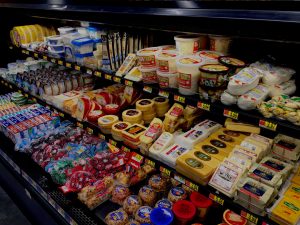
Walmart’s specialty cheese selection
Cheese? Although this is recognized as a standard product in nearly all households. The cheese selections of the two grocery stores differentiate greatly. Whole foods has an array of cheeses spread throughout the entire store. Some offer samples, such that you can again experience the store. This selection indicates that the consumers value more than just an ordinary cheese to put on their sandwich or crackers (no longer just American, Swiss, or Cheddar cheese). Rather, they possess the means to purchase more expensive cheeses for their households. There were few sliced mass amounts of cheese available at whole foods, indicating that the purchaser is likely admiring the cheese as cheese rather than an ingredient.
Walmart’s specialty cheese selection, however was covered in packaging and americanized brands. The selection was rather small, but the mass production of sliced, stringed, and squared cheeses made up for this lack. The need for such cheese in bulk has a relation to families as consumers, when needing to provide a snack for children, or making large home-cooked meals.
Hence, the consumers amid the two stores differentiates, and cheese is an indicator of this conclusion.
Protein Powder
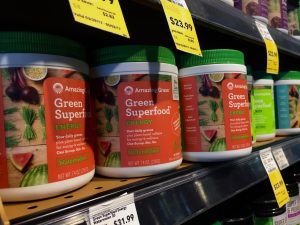
Whole Food’s protein powder
The health values of the stores are indicated in the protein powders that are available . The costumers of Whole Foods are recognized as more aware of their health and the chemicals they are putting inside of their body. “Green superfood” is perceived as a supplement to provide you your greens, rather than a product at Walmart that revolves around muscle building and the ideal body.

Walmart’s protein powder
The likely healthier option at whole foods, however, is only available to those that can afford the product. Thus, many are incapable of purchasing the healthier option leading to an unhealthy society and a society indicative of social divide because of their socioeconomic status.
Children’s Food
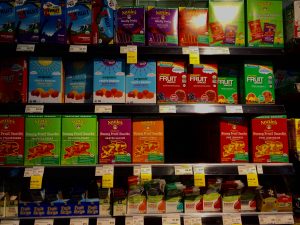
Whole Foods- children’s food (Gummies)

Walmart’s children’s food (Gummies)
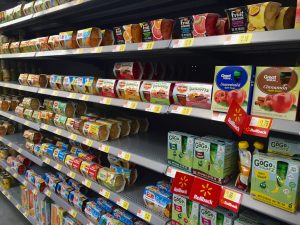
Walmart’s children’s food
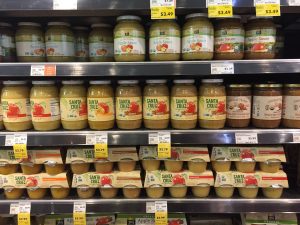
Whole Food’s apple sauce
Finally, the children’s food options are indicative of the obese society that is prevalent in America. Whole foods offers more expensive options for children’s snacks, but they are organic and produced with few chemicals. Also, they aren’t advertising toward children, rather they are advertising for the parents. The children, however, fall prey to the advertisements in Walmart, for their favorite television characters are on the box covers. These products, however, are extremely sugar filled, with few benefits. Hence, the promotion and purchasing of such products acts as an aid to childhood obesity.
Also the apple sauces of each of the stores indicate this differentiation and problem. There are the organic apple sauces in Whole foods, whereas in Walmart, there are sugar filled substrates of apples called “apple sauce”. Also the packaging illustrates the differentiation in sustainable values amid the two stores. Because Whole foods packages their apple sauce in jars, it is a more sustainable and reusable product; Walmart’s plastic packaging is less sustainable and indicative of the need for quick, disposable products for children.
Thus, the materiality of the grocery stores demonstrates the values of their customers and of our society.